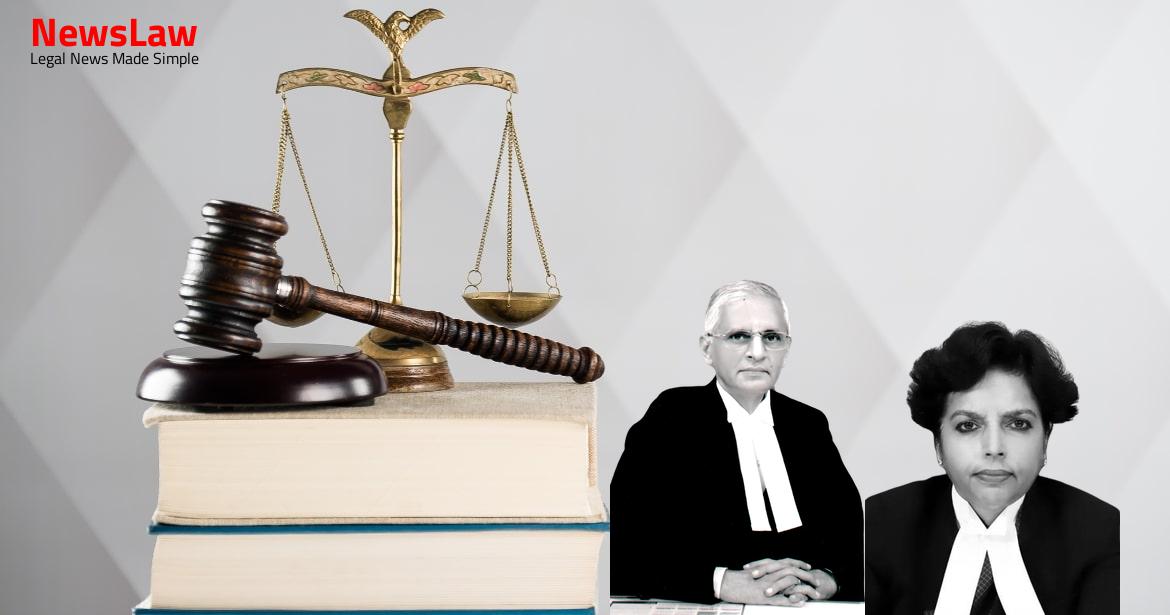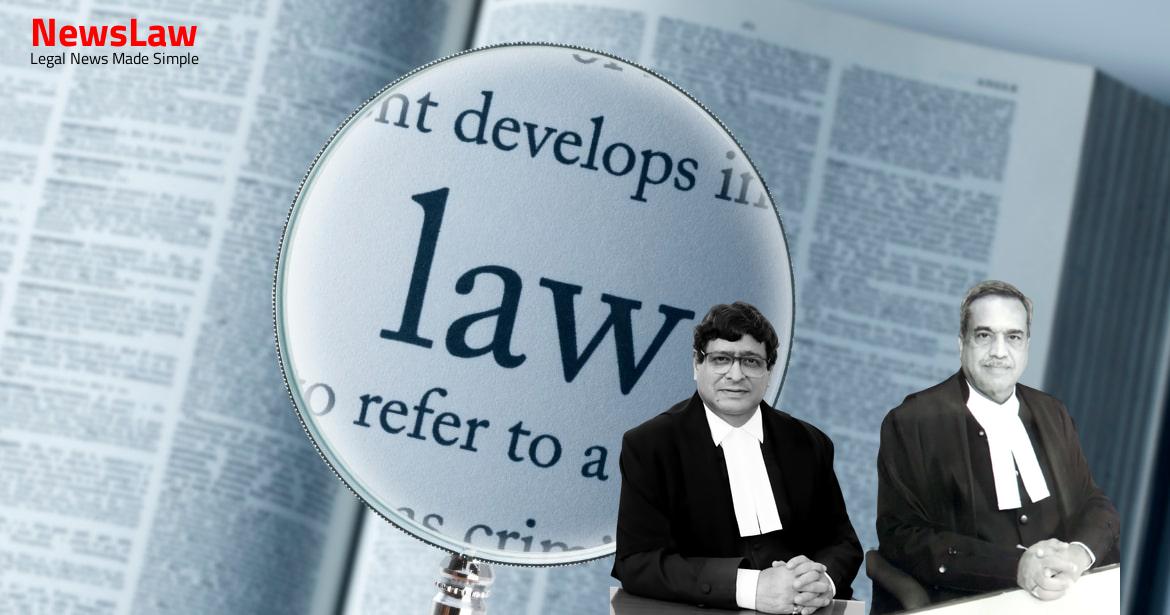Delve into a detailed legal analysis by the court in a recent murder conviction appeal case. The case reflects the importance of handling criminal cases with circumspection, particularly regarding evidence collection and admissibility. Emphasizing the need for a complete chain of circumstances in proving guilt, the court’s ruling sheds light on the complexities of relying on circumstantial evidence in murder trials.
Facts
- The accused were arrested more than 15 months after the incident in connection with the crime.
- Voluntary statements of the appellants were recorded by the Investigating Officer.
- A DVD marked as Exh. P-25 to P-28 was made during the recording of the statements.
- PW-14, K.H. Manjunath, testified to prove the signature on the Post-Mortem Report as the original examiner was deceased.
- The witness, Jayamma, mother of the deceased, was unable to identify the ornaments produced by the prosecution.
- The recovered gold ornaments were not part of a Test Identification Parade but identified by the relations of the deceased at the police station.
- Dr. Prakash Vishnu reported on the condition of the deceased’s brain hemorrhage during the post-mortem examination.
- The Post-Mortem Report detailed 13 injuries sustained by the deceased and the external wounds found on her body.
- The Deputy Superintendent of Police, N. Chalapathi, discussed the steps taken during investigation in relation to the voluntary statements of the accused.
- A chart, Exh.P-29, detailing the pending cases against the gang related to the appellants was presented during the proceedings.
- The appellants were found guilty of committing the offence under Section 394 of the IPC.
- The Trial Court sentenced them to life imprisonment initially.
- Subsequently, the Trial Court imposed death sentence upon all appellants.
- Accused No.9 died during the trial, leading to the abatement of proceedings against her.
- Original accused Nos.5 to 8 were acquitted, while the 2 appellants were convicted under Section 396 read with Section 34 of the IPC.
- The High Court did not find sufficient reasons to affirm the death sentences imposed by the Trial Court.
Also Read: Balancing Power and Transparency: Electoral Bonds Struck Down, Disclosure Mandated
Arguments
- Accused have committed a ghastly and gruesome murder in a highly depraved manner.
- Counsel for the appellants plead that accused have already undergone custody for more than 16 years.
- Accused were of young age at the time of arrest.
- No good reason found to take a lenient view in the matter.
Also Read: Recall of Resolution Plan Approval: Legal Analysis
Analysis
- The prosecution relied on four circumstances as evidence against the appellants, but the second and third circumstances were found to be unacceptable for consideration.
- The court emphasized the importance of only considering evidence that leads to the discovery of facts as per Section 27 of the Evidence Act.
- The accused’s voluntary statements were recorded on a DVD and played in court, which was deemed as inadmissible confession evidence.
- The court noted discrepancies in the recovery of missing ornaments and the delayed procurement of evidence.
- The court highlighted the need to handle criminal cases based on circumstantial evidence with caution and thorough examination.
- The involvement of the accused in other crimes and the handling of evidence were contentious points in the trial.
- The court criticized the airing of confession recordings on a TV channel, emphasizing the interference in the administration of justice.
- Several issues, including the uncovering of objects 15 months after the incident, lack of eyewitnesses, and reliance on circumstantial evidence, were raised in the trial proceedings.
- The court indicated shortcomings in the evidence presented, such as lack of Test Identification Parade for recovered ornaments and discrepancies in witness testimonies.
- Overall, the court expressed concern about the handling of evidence, including DVD statements, recovery processes, and reliance on charts for other crime involvements.
- The provision under Section 27 of the Indian Penal Code allows certain statements made by a person in police custody to be proved.
- For this section to apply, the discovery of a fact due to information received from a person accused of an offence in police custody must be deposed to.
- The information that can be proved is limited to that which distinctly relates to the fact discovered as a result.
- The provision under Section 394 of the Indian Penal Code holds not only the person causing hurt but also his associates equally liable to the act.
- All persons jointly involved in committing or attempting to commit robbery are encompassed within the purview of this section.
- Section 396 of the Indian Penal Code states that for the offence of dacoity with murder to be constituted, one of the five or more persons involved must commit murder during the dacoity.
- First and fourth circumstances are inadequate to prove guilt.
- Accused have pending cases of attacking women and committing murders.
- Accused do not deserve sympathy from the court.
- Lack of establishment of the second circumstance weakens the case against the appellants.
- The first principle is that the circumstances for concluding guilt must be fully established.
- Proof beyond reasonable doubt is necessary, although not a rigid mathematical formula.
- Circumstantial evidence is fragile and can have gaps or be unsubstantial.
- Inculpatory facts must be incompatible with the innocence of the accused.
- Presumption of innocence is crucial in murder cases relying solely on circumstantial evidence.
- Burden of proving innocence does not lie on the accused.
- All links in the evidence chain must be proven beyond reasonable doubt.
- Section 27 of the Evidence Act allows information provided during police custody to become admissible evidence.
- Hanumant v. State of Madhya Pradesh is a fundamental decision in relying on circumstantial evidence.
- Complete chain of circumstances must be established for circumstantial evidence to be conclusive.
- Conflicts between the presumption of innocence and other presumptions should prioritize the former.
Decision
- Criminal Appeal Nos. 799 of 2011 and 637 of 2012 allowed in part
- Conviction of accused Nos. 1 to 4 under Section 396 of the Indian Penal Code set aside
- Accused Nos. 1 to 4 sentenced to rigorous imprisonment for life and a fine of Rs.25,000/- each under Section 394 read with Section 34 IPC
- Benefit of doubt granted to the appellants leading to acquittal of charges
- Accused Nos. 1 to 4 held guilty of the lesser offence under Section 394 read with Section 34 IPC and convicted accordingly
Case Title: VENKATESH @ CHANDRA Vs. THE STATE OF KARNATAKA (2022 INSC 1302)
Case Number: Crl.A. No.-001476-001477 / 2018



